#picture on oscilloscope
Text

page 183 - When I was younger and in boy scouts, badges were it. I worked my way through the badge section of the scout book, applying for the badges I already thought I qualified for and working steadily to achieve the ones that asked for something new. I started working on one for trapping and skinning animals, really thought about where I should run my trap line and what kinds of animals I might catch. I didn't know how to trap but thought I could figure it out, or that the scout leader would eventually get around to showing us some techniques.
I didn't understand that a trap line wasn't something like a clothesline that you set up in the woods. You didn't walk the string every few days plucking off whatever creature had been unlucky enough to have its leg caught or its neck snapped. I never understood the mechanics of it all. And after months of waiting I re-read the book and noticed that badge was only available to boys who lived in the north where trapping happened.
Anyway, I feel weird. This badge is for identifying four supernovae and having your discovery confirmed by a national astronomical body.
#biology#biologist#zoology#zoologist#membrane#membrane polarity reversed#membrane reconstitution#membrane repolarized#picture on oscilloscope#diagram illustrating relationship between nerve impulses and the oscilloscope record they produce#spike#boy scouts#merit badges#merit#badges#gotta catch em all#astronomy#stars#intergalactic#interstellar#solar#solar system#galaxies#planets#james webb space telescope
24 notes
·
View notes
Text
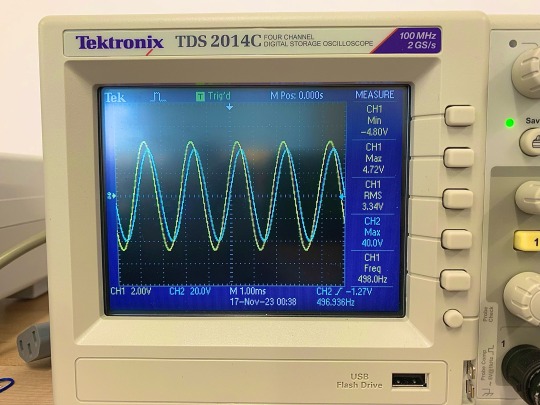
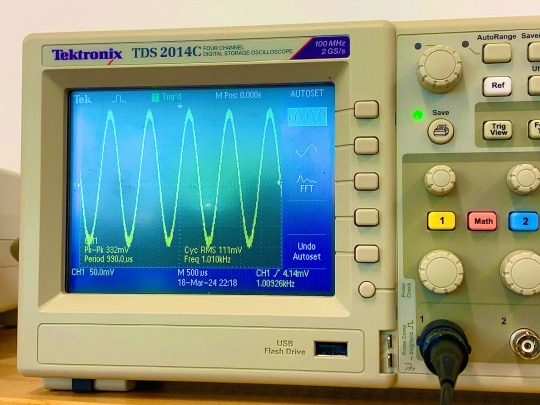
my beloved , 4-channel tektronix TDS2014C digital storage oscilloscope
#💾#📱#✏️#mine#tech#technology#oscilloscope#oscilloscopes#tektronix tds2014c#objectum#object romantic#objectum platonic#posic#os/or#osor#free to reblog#ahh. I dont have full images of them because i took the photos of their screen for assignments.#my professor told us these will be going soon. that they'll be getting new ones... I hope they reserve these oscilloscopes somewhere else.#i would hate to part with them..:#should i post my circuitry work from my other assignments? i dunno.Maybe ill take clear pictures of the breadboards i get to work with next#week. we'll see......
382 notes
·
View notes
Text
so remember the whole hooplah wjth printing my lab report this morning. yeah. well the TA wasnt even in the today so i didnt even have to do that
#also i printed it out#by separating it into two pdfs#i selected to print it in color bc of my oscilloscope pictures#but it printed out grayscale#so i printed it and then went over it in highlighters#which looked. sooo professional#and then i rushed to the lab room before my next class started#and the TA just. wasnt there#like. all that for naught ? alright#brot posts
0 notes
Text
A botanist, a biologist, a chemist, and a physicist were chatting together, as is known to happen, when the botanist stated: "Some people have the gall to say botany isn't a real science, just gardening."
"Well," says the biologist, "it is just applied biology.
"If we're being strict..." butted in the chemist. "Biology is just applied chemistry," followed immediately by the physicist:
"... Which is just applied physics!"
A mathematician, inexplicably not under the effect of stimulants, called from across the room. "Which itself is applied mathematics!" they said, before returning to their paper on the fuzziness of balls.
The physicist, incensed, stormed off, and returned a moment later with an oscilloscope, spirited away from somewhere, and which they plugged into something. "Have a look at this! This fundamental physical constant of the universe, this frequency, is something knowable to all intelligent life - your axioms and systems? All abritrary," they said, somewhat undercut by the oscilloscope picture being so misaligned as not to show anything at all.
A stranger leans over, to fiddle with the oscilloscope: "They're right; it's actually engineering that's applied mathematics. Physics," they said as they flicked the big, obvious, automatic gain control button on, "as plainly can be seen, is applied engineering." They stood, the image on the oscilloscope clear as day
'Ugh, who let an engineer in here?' every other person present thought in unison.
"And if we're being strict..." the engineer continued, "historically speaking, because of the social, political-economic reasons for the development of advanced number systems... it's actually mathematics that's applied botany."
Immediately, the fire alarm went off, because their coworkers had meanwhile been arguing over fire extinguishers while their office was ablaze.
Note: given random chance, the above tale has a statistically significant likelihood of being true, but contains one obvious factual inaccuracy: the absurd notion that an engineer could be in the room without immediately making sure everyone else knew it.
365 notes
·
View notes
Text

A few people took exception to calling my car's CD player useless.
I actually think it is great there are a few holdouts still using CDs.
CDs are truly one of the most perfect media ever created.
And I can prove that mathematically.
Some will say vinyl is superior. And as much as I love records, the audio quality is preferred, not better. People have a *preference* for how vinyl sounds, but it still leaves out audio information and has noise and artifacts caused by the mechanics of the turntable and an imperfect manufacturing process.
In fact, the lesser audio quality is exactly what people enjoy. It has a warmth and comfortably compressed dynamic range that is not fatiguing over long listening sessions. It's like choosing a nice fire over a 100% efficient space heater.
But if you want perfect audio quality that does not exceed the limits of human hearing, compact discs are where it's at.
It all has to do with Dr. Harry Nyquist and his Nyquist-Shannon Theorem. (Sometimes Shannon gets left out and it is just called the Nyquist Theorem.)
The simple version is he figured out how much something needs to be sampled in order to not lose any information. As long as you sample something at a frequency greater than or equal to twice per cycle, you will have a lossless... whatever.
In this case, a lossless audio recording.
So the range of human hearing is about 20 Hz to 20 kHz. That's the lowest and highest frequencies we can perceive. The scientists creating CD audio figured they'd do 22 kHz for some overhead and then you double that to get 44 kHz. (Technically it was 44.1 kHz.)

You can imagine the smooth curvy line as an analog recording. No gaps. No information loss.
The black squares are digital samples recorded over a period of time. You can see there are gaps between those black squares. A tiny bit of time passes between the squares where nothing is sampled. INFORMATION LOSS! NOOOOO!
Clearly the vinyl nerds are correct and digital is inferior, right? You are going to get the dreaded... STAIR STEPS!
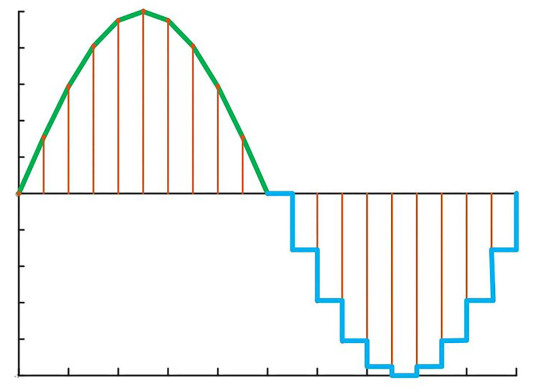
Not so fast, bucko!
By getting enough samples over a period of time, you can use math to infer that smooth sloping line connecting those individual samples. So the digital recording also has no information lost once it is converted back to analog and played through your speakers.
This connecting of dots is called "interpolation."
You could take the curvy analog, convert it to digital, get the same black squares, and then interpolate the black squares back into analog and get the same curvy line. It goes back and forth perfectly. And this is all verifiable with an oscilloscope.
NEAT!
Then of course you need a good dynamic range--the spectrum of quiet to loud. Anything above 85 decibels will damage your hearing, so they went with a 16-bit depth which covers roughly 100 dB. Again, giving them a little overhead for death metal and overzealous trumpet players.
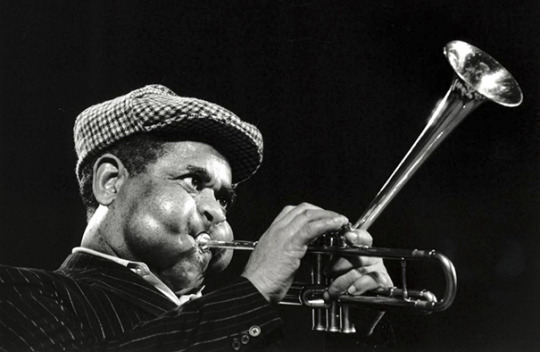
And the final component is data bandwidth or "bitrate" usually measured in kilobits per second. This is how much data is read every second. The 1s and 0s of it all. The bitrate of a CD is calculated by multiplying 44,100 samples per second per channel by 16 bits per sample and then multiplying by 2 channels. After all that mathing is math'd, you get a perfectly uncompressed 1,411 kbps.
So you've got all the frequencies you could ever hear combined with as much volume as your ears can stand with a bit rate that will give you no loss of data.
The *perfect* audio quality all encoded into little microscopic pits.

Now you may be asking, "Why do I see "24/96" or "24/192" advertised on fancy audio equipment and high quality streaming platforms like Tidal? Aren't 24 bits better? Isn't 96 kHz MORE than 44.1 kHz?"
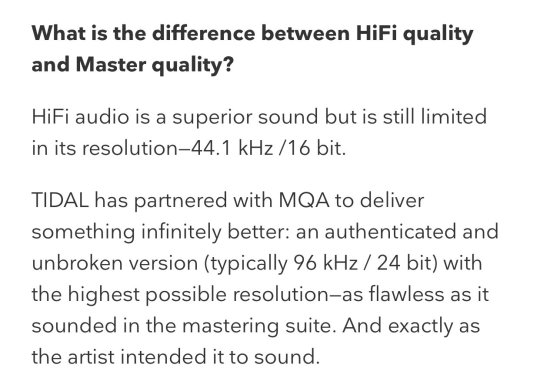
Dr. Nyquist might say... this is some bullshit.
This confusion comes from the fact that recording quality and playback quality are two different animals. This misunderstanding happens with video and photo quality as well. Recording in 6K will give you a sharper picture even if your final playback quality is 4K. You can get bad pixels and noise and stray photons that do not contribute to the detail in the video. By giving yourself overhead you can ensure you hit the desired quality target.
And recording at 24 bits and 96 or 192 kHz, you get a higher resolution to edit and master with, but it is only advantageous to the computer software... not the human ear.
From a photographer's perspective, I relate to it like this...
If I have more megapixels and more colors and more dynamic range I have more leeway when editing my photos. If you try to push a low quality photo in the edit, it has this tendency to fall apart. You can get ugly color banding and harsh contrast and sharpening artifacts. By capturing more quality than you need in the finished product, you can process the photo much more dramatically before it deteriorates and loses integrity.
Audio and video are the same way.
So let's say you have a metal singer that screams at the microphone as loud as possible from 2 inches away.

At 16 bits they may surpass that 100 decibel dynamic range and distort the recording. But if you record in 24 bits, you get 144 dB to play with. Or you can even do 32 bits and get 1500 dB--a volume that no human voice could ever surpass. It guarantees a clean, distortion free recording, but 32 bits would be pointless for human listening.
The same is true with the sample rate. Having a higher resolution allows you to zoom into waveforms and adjust things to an extremely granular level. You can do precise timings, tiny pitch adjustments, apply loads of digital effects, and just have more room for audio activities without degrading the sound quality.
But outputting 192,000 of those black squares is going to interpolate the exact same smooth curvy line as 44,100 when it is played through speakers.

The oscilloscope knows what I'm talking about.
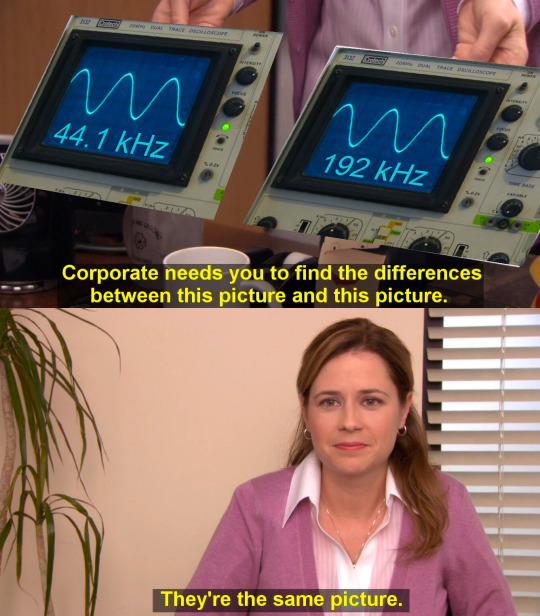
Now I am about to reveal a secret that no audiophile who has invested in a $115,000 high resolution 32 bit/3,072 kHz DAC wants to acknowledge...
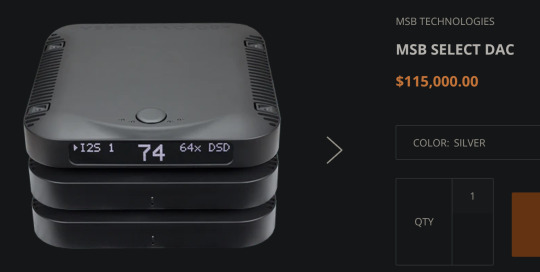
The master recording is always more important than the playback quality.
If you have a high quality source it will sound great even in a highly compressed MP3. Just like the 6K video is sharper on the 4K TV. And the high megapixel photo looks better in an Instagram post.
If the source is good, the media will be good.
And since high resolution audio services often seek out the best masters available before encoding their playback files, it gives many people the illusion they are getting better sound quality due to the boosted specs.
When in reality, it was just a better copy of the original recording.
According to Nyquist, your human ears are not computers and all you need is double the frequency to hear perfect sound with no loss of information. So anything above 16 bit/44.1 kHz/1411 kbps and you are just wasting bandwidth on a server.
And I don't want to hear anything about "stair stepping."
IT'S MATH.
Your ears aren't better than math, okay?
If you don't believe in math, then you and Jack White can sit in the naughty math corner with his bespoke overpriced vinyl pressings.

I will say, there is a gap between your standard music streaming service like Spotify and your bullshit audiophile service like Tidal.
Free Spotify uses heavily compressed files. Which means the bitrate is quite low and there can be information loss. Or "lossy" compression. Modern compression is actually pretty amazing, but I'm afraid anything below 320 kbps may cause some songs to not sound as intended.
Depending on the content, some songs are more suited to compression than others. And even with premium Spotify, they cap songs at 320 kbps which still may not be enough for busier, harder-to-compress songs.
Also, I don't know if Spotify cares about getting the best quality master for a given song. Which, again, is the most important aspect of sound quality.
But services like Tidal waste bandwidth with their super specs and that isn't great for the environment. What I'd love to see is a company that makes their best effort to seek out high quality masters, and encodes their files at 16 bit/44 kHz with a lossless variable bit rate compression. Variable bit rate or "VBR" will do more compression during simpler parts of the audio and less compression during more complex parts. It's smart compression, basically. And as long as you use a high enough bitrate to achieve lossless compression, the sound quality will be the same as if there is no compression at all. So you still get smaller file sizes that use less bandwidth and have a smaller environmental impact.
That would be a streaming service I would consider paying for. Especially if they put great effort into getting high quality original recordings for their content.
In conclusion... if you are still using CDs you don't need to worry about audio quality. You're all set. There is a sort of beauty in what the audio scientists who created compact discs did. They figured out the limits of human audio perception and created a format that just slightly exceeded that. No "bigger number is better" marketing. No audiophile bullshit.
They said, "Here is what you need and nothing more."
They made a perfect thing and they should be proud of that.
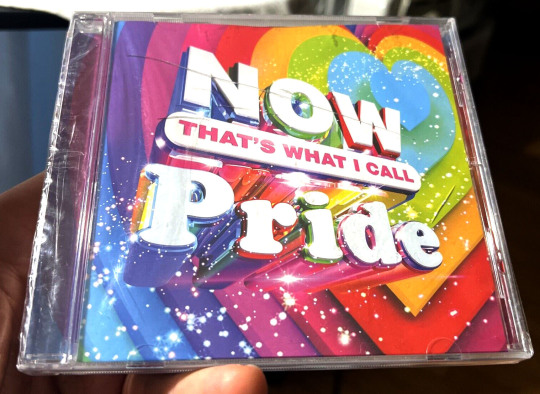
436 notes
·
View notes
Text
VCF Southwest
This was the first time I've been able to attend a VCF, and it was the first held in the Dallas area in over a decade. I was lucky enough to participate as both event staff, helping to plan and run the show, and as an exhibitor. It was exhausting, it was overwhelming at times, and I nearly lost my voice by the end of the first day ... But it was also an incredible experience and I really enjoyed it.
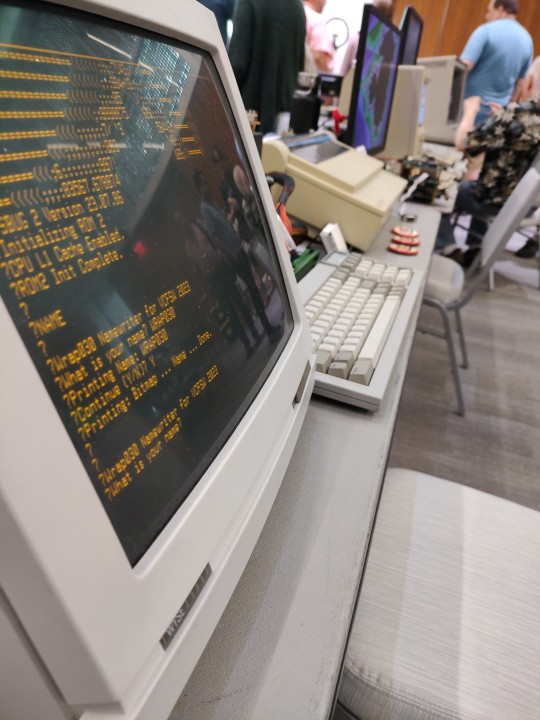

I brought a few of my projects to show off. First and foremost was my Wrap030-ATX project, which I paired with a Wyse WY-30 terminal I rescued from Computer Reset, and had running a demo program for printing names on my recently-repaired Apple ImageWriter II/L. Next to that was my Wrap030 board stack running a Mandelbrot fractal renderer using its 68882 FPU and video generator cards. Then came the Mac SE from Computer Reset I repaired, with my SE-VGA card driving an external monitor, and running Oregon Trail (always a crowd favorite!). Finally I had my Franken-Plus, which sadly suffered a power supply failure early on the first day and sat dark all weekend.
My exhibit was situated just down the row from @commodorez , who won the show's Best Microcomputer award for his "VICs that aren't 20" exhibit of rare and lesser-known Commodore computers. Across from Commodore-Z was Usagi Electric, who won Best in Show for his exhibit of the Centurion, a PDP-11, and his vacuum tube computer.
I had a great time talking to Commodore-Z, @ms-dos5 , Usagi Electric, Nybbles and Bytes, Macintosh Librarian, Retrotech Chris, Kevin & Michael of the Turbo 9 Team, Al Williams, and so many more wonderful people that I couldn't even begin to catch names for.
I also got to go into deep-dive discussions on very specific details about my projects with people who already knew so much more about the components and the tools that I'm using than I do. It's energizing to be around people that understand the work that goes into these projects and appreciate what I've accomplished.
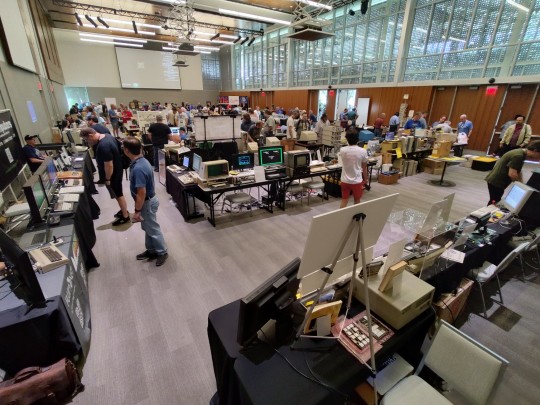


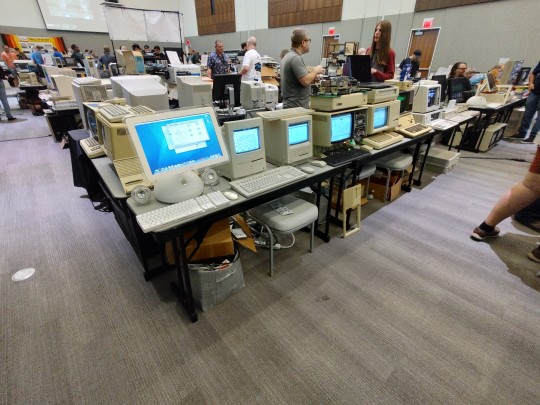
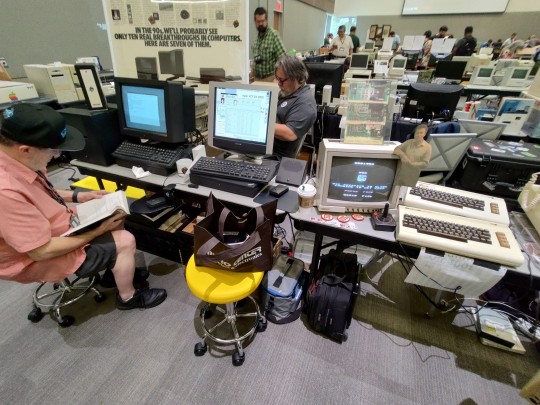
The show was so much bigger than I anticipated. Including staff, volunteers, sponsors, speakers, exhibitors, and attendees, we saw nearly 900 people come through the main hall over the course of the weekend. Seminars were full, with CuriousMarc's presentation on Restoring the Apollo Guidance Computer forming an imposing line for entry well ahead of the scheduled start of the talk. We had incredible community turnout; it was great to see entire families come through with awestruck small children in tow.
There was so much to see and do, so many people to talk to. The entire weekend is just a blur. My brain is still trying to process everything from the show.
One thing does stand out though — an unbelievably generous act from someone I spoke to on Saturday about my homebrew builds and my methods for testing and debugging. This kind soul was so impressed by what I have accomplished without an oscilloscope that he bought one from the VCFSW charity auction and gave it to me on Sunday. I was so surprised I didn't think to even get his name before he disappeared into the crowd. I can't wait to put it to good use, and I hope that what I build with it lives up to his expectations.
Following VCF East earlier this year, Bil Herd said something about riding that high from VCFE, and that prompted him to agree to come out to join us at VCFSW this year. Now that I've experienced it for myself, I understand what he meant. I've been looking though all the pictures and blog posts everyone has been sharing, and catching up on recordings of the presentations I missed. Interest in some of my projects has me thinking about what I can do with them next. It's exciting.
I can't wait until next year.
#vcf southwest#vcf#vcfsw#vcfsw 2023#vintage computer festival#vintage computing#retro computing#wrap030 atx#SE-VGA
115 notes
·
View notes
Text
Well, I didn't realize it would be such a difficult exercise in CV routing and modulation, but by fuck I'm going to make a picture of a roly poly on this oscillioscope. All of my experience in eurorack thus far has been "Oh, does this sound good? Yeah, I'll keep it then," so uh... progress is slow.

If you were wondering, yes, this is entirely so I can use it as a pfp for this blog.
A description of what the hell any of that is is below the break:
Green signal: Just a rectified sine from Pam's that I synced with the scroll speed of the oscilloscope. Its determining the main shape of the roly poly.
Red signal: A square wave LFO that's being run through a VCA modulated by that Pam's signal.
Blue signal: Currently, the red signal through an adder, but yeah. That aint it. I'm trying to raise the minimum CV of the red signal such that the arc above stays at the same height, but the the bottom arcs some as well, so he's shaped like a little croissant. But I think I need to do more VCA sulduggery to make that actually work.
Yellow signal: ain't doing shit.
#eurorack#hi wider eurorack may be obvious that i have no idea what im doing#this is factual#but hey if you feel like giving any tips and/or tricks id be very appreciative
8 notes
·
View notes
Text

I was playing around with an old analog oscilloscope today, I was trying to see if I could at least get it to show tones generated from the computer, and guess what! you can!
I was taking pictures to show a friend and most of them looked like shit, but I realized it probably was because of the shutter speed. I used the pro photo mode on my phone turned the shutter speed down to 1/60th of a second, and it's cool because you can actually see the wave as it's being drawn here, and the artifacts/ghosts of the past 5 or 6 waves that were drawn too. very cool stuff
15 notes
·
View notes
Text
Humans make art with computer vision tools the same way humans made art with oscilloscopes and data plotters and 3D modeling tools; it turns out the people who like to play with fancy technology also like to make pretty pictures.
7 notes
·
View notes
Text

It's November 9th, 🌌 Carl Sagan Day! On this day in 1934, the brilliant Carl Edward Sagan was born in Brooklyn, New York, USA. A trip with his parents to the 1939 New York World's Fair sparked Carl's lifelong interest in science. He was fascinated by scientific exhibits that turned a flashlight beam into a crackling sound and the sound of a tuning fork into a wave on an oscilloscope. He was also enthralled by an exhibit featuring the technology that would replace radio – television. The future held wonders!
Carl never lost his childhood passion for science. After he graduated from the University of Chicago with BA, BS, MS, and PhD degrees, he had a distinguished career as a professor at first Harvard and then Cornell. But that was just the foundation of his illustrious career.
He went on to become America's pre-eminent astronomer, planetary scientist, cosmologist, astrophysicist, and – the role he is most famous for – science communicator. It seemed at the time that his crowning achievement was the 1980 blockbuster PBS documentary series "Cosmos," which he wrote, produced, narrated, and starred in.
But Carl went on to do so much more. He wrote popular books such as "Pale Blue Dot," "The Demon-Haunted World," and "Contact" (which Hollywood turned into a movie starring Jodie Foster). He helped send the first physical Earth messages into outer space – the Pioneer Plaque and the Voyager Golder Record. He convinced NASA to turn Voyager's camera back toward Earth to take a picture of us from six billion kilometers away before the space probe left the solar system. This resulted in the famous "Pale Blue Dot" image.
Carl Sagan died of pneumonia much too young at the age of 62 on December 20, 1996. The world misses you immensely, Carl. ☮️ R.I.P… Jamiese of Pixoplanet
#Jamiese#Pixoplanet#carl sagan#cosmos#science#neil de grasse tyson#astronomy#nasa#space#universe#astrophysics#spacex#stephen hawking#physics#cosmology#elon musk#black hole#albert einstein#einstein#ciencia#astronomia#quantum physics#fisica#universo#nikola tesla#richard feynman#stars#galaxy#particle physics#astrophile
94 notes
·
View notes
Text

page 183 - merit badge railway sign
#biology#biologist#zoology#zoologist#membrane#membrane polarity reversed#membrane reconstitution#membrane repolarized#picture on oscilloscope#diagram illustrating relationship between nerve impulses and the oscilloscope record they produce#spike#merit#merit badges#boy scouts#scouts#baden powell#beavers#cubs#nft#railway#train#signal#do not cross#safe to cross#signs#signage#the 4 o'clock from new orleans#tracks#track#track of the day
11 notes
·
View notes
Text


day 79 of 100 days of productivity 💌
another day of higher productivity than usual. got my AS paper 2 back,,, it was lower than i thought, 65/80, BUTTTT there’s one good thing coming out of this: i don’t actually lack any AS knowledge. TEN of the marks i lost were from some ridiculously embarrassing mistakes. the other five were miscellaneous marks scattered across. i had a bad feeling prior to getting the paper back and yeah it makes sense. so while i’m not satisfied with the score itself, i am happy knowing that i’m on the right track.
went home and worked on some trigonometric identities and some polynomial long division, and did some coding work. i have my computer science trial in two days, which i’m terrified for. but i think a bit more revision and i’ll be fine.
pictured is the projection of an image produced on an oscilloscope during physics class today. my teacher hummed a note into the microphone, producing a near-perfect sine wave. it was so fun, bless my teachers :)
- J
2 notes
·
View notes
Text




i am fighting my way through the semester at this point. it's me and my three journals against the world. second picture is a shot i must've taken by accident when my friends i went to karaoke 🎤, and third picture is from my lab class ft. an oscilloscope
it's a fun little gadget to use, and i'm sure i'd enjoy it more if it didn't have such a hefty pricetag 😭😭 i was so nervous handling it
exam season is finally upon us, and i find that i'm not as terrified as i'd usually be just bc the vibes of october are so immaculate. i'm looking forward for the halloween season to really kick off since my friends and i are planning to dress up 🧶
speaking of spooky season. i just got into ride the cyclone, and the timing is literally perfect. nothing beats rushing to my classes to the tempo of noel's lament 🌟🌟
#my favourite songs are jawbreaker and sugar cloud though#like. goddam#u go constance#physicsblr#physics#studyblr#studying#study#student#college#university#productivity#learning#motivation#studyspo#photooftheday#aesthetic#bullet journal#bujo#journal#planning#humbly#starot
26 notes
·
View notes
Text
Jamie Lee Curtis Sparks Uproar Over Framed Photo of Naked Child in Box | PetaPixel
Hollywood actress Jamie Lee Curtis has deleted an Instagram post after facing backlash for her choice of photography wall art.
Curtis posted a picture from inside her house last week showing “beautiful Pollack chairs” from her latest movie Everything Everywhere All at Once in her office.

Reactions in the post’s comments and on social media were largely focused on the strange framed photo on the wall behind the desk and chairs, as it appeared to show a naked child inside a plastic tub.
Critics questioned the actress’s taste in art, calling the photo ���creepy” and “sick.” Others on social media drew connections between the art and everything from Jeffrey Epstein to the recently Balenciaga BDSM scandal.

Curtis quickly responded by deleting the Instagram post, but social media continued to swirl. Today, Curtis took to her social media channels to address the matter.

“Last week I posted a picture of some chairs that included a photograph on the wall by an artist that was gifted to me 20 years ago,” she writes.
“I understand it has disturbed some people. As I have said, I am a truth teller so here’s the truth. It’s a picture of a child, taken by her mother, of her playing in their backyard in a tub of water. Nothing more, nothing less. I took down the post because I didn’t want to keep something up that upset anyone.”
The Photographer Behind the Photo
The controversial wall art is a print of a photo by American photographer Betsy Schneider. It’s from her series Sweet is the Swamp, a collection of candid photos taken mainly of the photographer’s children. The picture that Curtis owns is called The Tub and was taken in 2003. The image shows Schneider’s daughter in a small plastic box filled with water.
Schneider was one of around 175 individuals around the world that was awarded a prestigious Guggenheim Fellowship in 2011.
Past Controversies
Photographer Betsy Schneider documents transformations of individuals and families over time and place, according to her website.
Her work has been exhibited in art galleries and Schnieder has released a book entitled To Be Thirteen.
Schnieder’s work has caused controversy in the past. In 2004, police in London were called to her exhibition at the Spitz gallery after concerns were raised over photos of the artist’s naked daughter. A visitor to the exhibition considered the images to be pornographic and the exhibition was shut down by the gallery.
She told The Guardian that she did not consider the work to be obscene when seen as a whole.
“The aim of these pictures is not to provoke or to shock. The idea is to show time, change and growth,” she said at the time.
Update 1/20: This article has been amended after the photographer reached out to PetaPixel claiming that she never said her photos might be considered pornographic. This was misquoted at the time and PetaPixel has removed the quote.
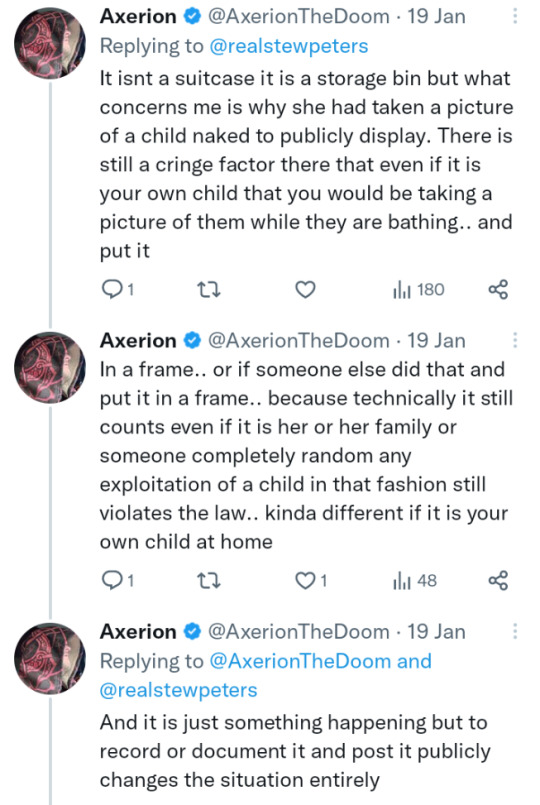

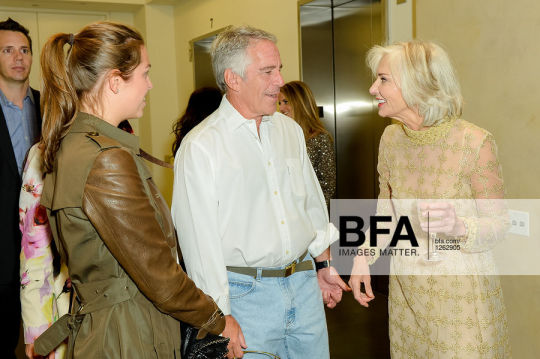
A24 was founded on August 20, 2012, by film veterans Daniel Katz, David Fenkel, and John Hodges. Katz formerly led the film finance group at Guggenheim Partners, Fenkel was the president, co-founder and partner at Oscilloscope, and Hodges served as Head of Production and Development at Big Beach. The name "A24" was inspired by the Italian A24 motorway Katz was driving on when he decided to found the company; coincidentally, the motorway is also renowned in Italian film history as the setting of many small Abruzzan towns and rural landscapes employed in the films of neorealist and surrealist masters....Guggenheim Partners provided the seed money for A24. The company was started to share "movies from a distinctive point of view"...In January 2016, Sasha Lloyd joined the company to handle all film, television distribution and business development in the international marketplace. The company, with cooperation from Bank of America, J.P. Morgan & Co. and SunTrust Banks, also raised its line of credit from $50 million to $125 million a month later to build upon its operations..."
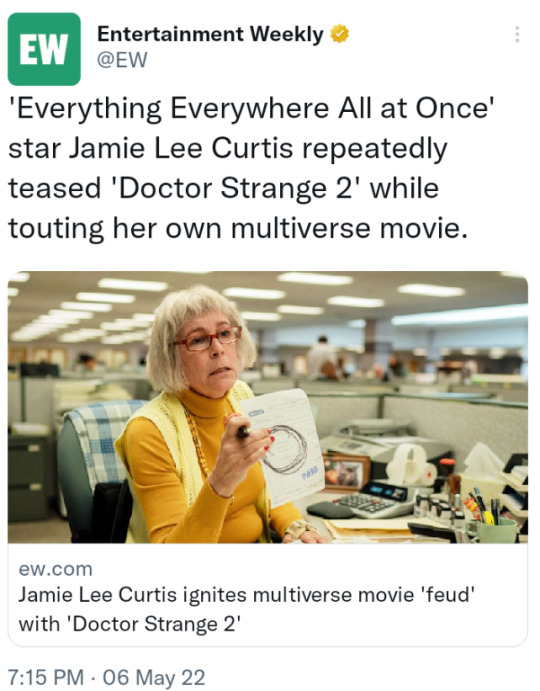

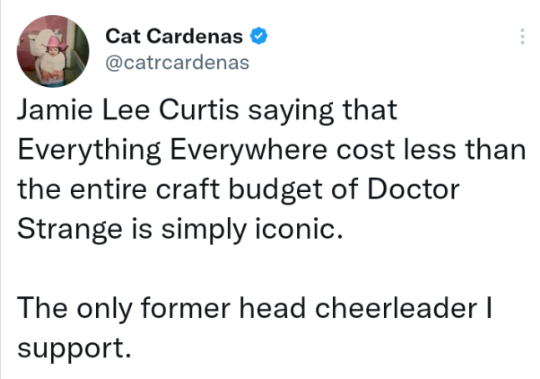
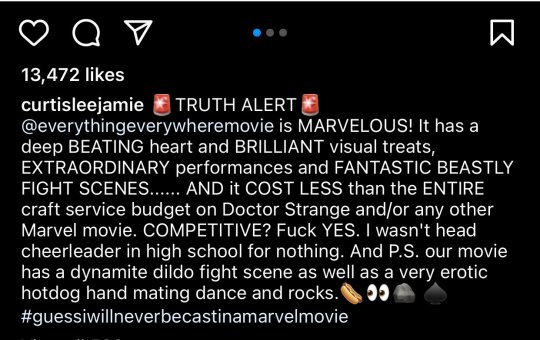
I know there's lots of competition between movies these days, but it was always very weird that Jamie Lee Curtis so pointedly and repeatedly kept targeting the Benedict Cumberbatch-led film, Doctor Strange In The Multiverse of Madness. To date, I'd never seen any so-called professional actor/actress behave that way.
There was, indeed ZERO reason to do this, UNLESS...!
5 notes
·
View notes
Text
Oscilloscope to Release MOON GARDEN in theaters 2023.
Oscilloscope has acquired world wide rights from Fire Trial Films to Ryan Stevens Harris’s MOON GARDEN and is planning a traditional theatrical release for the film in 2023.

Five-year-old Emma’s life teeters between happy moments and intense parental conflict. Comatose after an accident at home, Emma is propelled into a journey through an industrial wonderland, encountering various strange and visually intriguing figures and situations inspired by her imagination, on her way back to consciousness. Shot on expired 35mm film stock with vintage lenses, and utilizing stop motion animation, practical effects, and miniatures, MOON GARDEN is a meticulously constructed, lush, dark, fantasy odyssey.
Filmmaker Ryan Stevens Harris said, “We’re so thrilled for MOON GARDEN to find a home with Oscilloscope. They were always our first choice to handle the film’s release as I’ve always admired their nuanced white glove approach with each of their pictures. They have this uncanny ability to ingrain a film in the cultural zeitgeist, something truly rare nowadays. MOON GARDEN is a unique project, years in the making—a dark fantasy dashed with bittersweet drama, filtered through the dark lens of a midnight movie. We knew we needed a partner who embraced all the film’s aspects and would put as much care into its release as we did into production. Oscilloscope is the perfect partner and we couldn't be happier.”
O-Scope’s Dan Berger said, “MOON GARDEN is a sight to behold. A long-gestating labor of love, Ryan’s film has all the pomp of a $100m studio sci-fi epic, but a tactileness that studios could never achieve. You can feel the sweat poured into every frame to render this deeply touching, deeply strange, and deeply resonant film that is clearly the work of a visionary. We can’t wait to bring this to audiences far and wide.”
Filmmakers Ryan Stevens Harris and John Michael Elfers are the award-winning team at Fire Trial Films—a boutique production company focused on 35mm. The full-service company handles projects from pre-production to post and owns and maintains its own equipment, including a fleet of film cameras and support, grip and lighting as well as 4K film scanning. Past features include BEYOND WHITE SPACE (2018), DISCARNATE (2018), and FINALE (2010).
#film news#movie news#acquisition#oscilloscope#moon garden#fire trial films#ryan stevens harris#stop motion animation#practical effects#sci-fi#epic
12 notes
·
View notes
Note
does the pfp being a black square with a colored circle mean anything? ive seen a few people with the same kind of pfp as you and i was wondering
really? huh. i havent seen anyone else with a pfp like mine ever since squid game stopped being the show of the month
mine is just a screengrab of an oscilloscope displaying a circle, doesnt really have any significance beyond me never really having a proper profile picture. ill get around to making one eventually...
1 note
·
View note